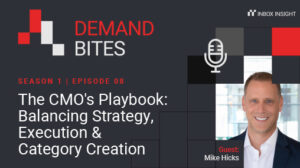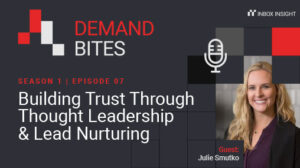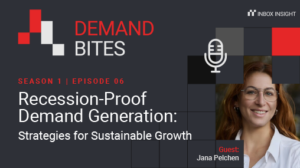Reading time: 3 minutes
Account-Based Marketing (ABM) is here to stay, that much is clear. Its allure is evident; hand-pick the specific organizations you wish to sell to, ensure your marketing efforts are hyper-targeted, drive engagements that ultimately end in profit.
However, with a lack of understanding of the fundamental account based marketing tactics underpinning a successful digital marketing approach, campaigns can easily be unstructured, mismanaged and poorly executed – and we are at risk that this may also stick around, unless a handful of key tactical elements are held up to scrutiny.
What’s more, with the new wave of Data Analytics and Attribution Modelling having already broken, there has never been a better time to take a deep-dive into your ABM strategy. From the criteria used to create target account lists in the first instance, to the detail and targeting used to implement it, there are a number of considerations to bear in mind when launching into your next Account-Based Marketing campaign…
Mistake #1: Unsustainable Target Account Lists
Unsustainable Target Account Lists (TALs) are, by far, the most common problem when undertaking any ABM activity. A limited number of accounts to target will clearly translate to a limited number of contacts. Depending on how you set up these campaigns, you could be reaching out to the same decision makers through a variety of different publishers and channels, often generating the same leads (and therefore repeatedly paying for them).
By paying attention to the way this list is formed, we can extrapolate certain factors to potentially double, triple or quadruple the number of accounts you could reasonably target. Let us take, for example, a list which holds the following ‘Target Accounts’:
Lloyds
NatWest
Santander
RBS
Barclays
Where many B2B marketers are going wrong is to take this list at face value without considering the opportunity to expand it to include all other large, UK-focussed retail/high-street banks, a tactic that can instantly expand your available reach:
HSBC
Standard Chartered
Halifax
TSB
Metro Bank
Sainsbury’s Bank
Tesco Bank
These ‘lookalikes’ may seem glaringly obvious but yet somehow go unnoticed. Perhaps because in the quest to become hyper targeted, we can also become tunnel-visioned.
To avoid falling down the same pothole, thematic reasoning techniques such as firmographic data is a strong B2B marketing segmentation technique used for building or assessing your TAL.
This is achieved through leveraging specific data to form the criteria for shaping your audiences into meaningful segments. For example, by analyzing what makes an account attractive to your business and using this insight to spot other accounts that share these same salient characteristics, you can expand your target audience without diluting relevance to your key market offering.
Industry, Company Size, Company Type, Ownership, Trends and Intent Tags are just a few types of firmographic data examples that can be used to form the rationale behind your B2B segmentation and targeting strategy.
There of course instances where this practice won’t be relevant – if you form any TAL from a list of lost opportunities from the previous financial year, for example, you may be looking to be hyper-targeted and run personalized messaging. If there is a growing theme within that list itself however, don’t rush to dismiss this potential growth opportunity.
In these cases, firmographic data around trends and intent data is something to be especially aware of, irrespective of the size of the Target Account List you are working with. Either by layering this on top of the list you are working to, or utilizing Intent Data to expand upon the organizations you are looking to target, the tracking of intent signals – either by content consumption or area of interest – can help ensure your targeting is at its most effective.
Mistake #2: Leaving the ‘A’ out of ABM
Briefs and Campaign plans surrounding ABM activity are obviously focused on generating demand from a select number of companies that you feel your products or services would particularly benefit from. Often, however, we come up against a targeting issue no bump in TAL numbers can ever truly fix – Job Titles.
As a salesperson or B2B marketer, being able to speak to the direct budget holder, Director or C-Suite decision maker is a dream come true. However, discarding other members of the Decision Making Unit (DMU) such as influencers, lower-level job titles or the individuals that make up the team, can be a big mistake. Sure, senior stakeholders yield greater influence at latter stages of the B2B buying process, however, without strategically targeting stakeholders aligned to the earlier stages of the buying process, you may be reaching too far up the chain, too early.
ABM works at its absolute best when surrounding a given organizations’ key decision making department(s) with the right messaging at the right time, as a whole, at varying levels of the funnel. In a recent benchmark survey report, Klaudia Tirico noted that “[respondents] are taking strides to deliver targeted content tailored to specific industries (64%) and specific roles (51%), as well as personalized content for each account (45%).” (Demand Gen Survey Report)
Persona-based targeting, with a focus on each tier within any one business area, can be incredibly lucrative when run in parallel. A full suite of tailored assets, combined with cross-channel activity targeting all potential influencers across a variety of job roles and seniority levels gives the highest chance of success.
Mistake #3: Ignoring the need for Sales AND Marketing alignment
Before any ABM activity can begin, both sides need to agree on, and understand the goals, KPIs and metrics they are working towards, together. This alignment – through shared insight and a combined drive to deliver the best approach – is the only way to expand relationships among your key accounts.
One thing to pay attention to, especially when looking to target a particularly limited set of accounts, is whether this is the type of play better suited to be run internally via your Sales and/or Business Development teams alone. The cost of enlisting your own experts to reach out to these businesses and educate them on your products and services, especially when at the scale of double- or early triple-digits, may be considerably more cost effective and commercially viable than looking externally for assistance. Matt Heinz, Founder of Heinz Marketing, puts it particularly well: “That list of target accounts? That’s not a three month campaign. That’s your list, man! That’s who you want to sell to – today, tomorrow, next quarter, next year, whatever & however long it takes.” (Heinz Marketing).
It is important to remember that as ABM is a full-funnel strategy, not simply confined to Marketing, key stakeholders across the business should be able to track and understand the reasoning and execution of your campaign throughout its lifecycle.
For further tips, we provide several strategies for achieving better B2B sales and marketing alignment.
Mistake #4: Domains, Domains, Domains
When building out a target account list, especially when briefing out to publishers and 3rd party suppliers, it is of particular importance to provide as much data on each account as possible. At the very least, the provision of a web domain per account should be sought, as this allows an exact match count to be run against any data that is being targeted – internally or externally. Partial matches against Company Name data can be frustrating for all involved, and can often result in improper targeting and wasted inventory. The sources used to collate and create ABM targeting and TALs should allow this data to be extracted – and it is of vital importance that it is.
Mistake #5: Multiple Accounts, Multiple DM’s, Multiple Channels, Multiple Touchpoints
When applying the finishing touches to your ABM approach (ideally having curated an extensive list, through multiple data sources, with a set of domains and a broad list of job titles ), getting the channels and messaging right is of vital importance.
Any number of decision makers can be sought and engaged with at different times of the day, through a variety of different media with a differing level of subject-matter interest than their peers, and it is only when a campaign truly caters to all potential influencing parties that it performs at its best.
Content syndication is a great way to engage individuals and generate leads, but have you considered Social? Programmatic is a fantastic way of getting your message out in a digestible format, but have you attempted this via email?
It is not only the choice of channels and the type of messaging, but the frequency, reach and combination of these elements which will truly allow your message to permeate across your key target accounts, and give your Sales and BDR teams the best possible opportunity to win their business for you.
After all, that’s what all this is about, isn’t it?
To learn more about running better ABM campaigns that put these tips into action, read about our product suite here or get in touch with one of our Demand Generation specialists.







